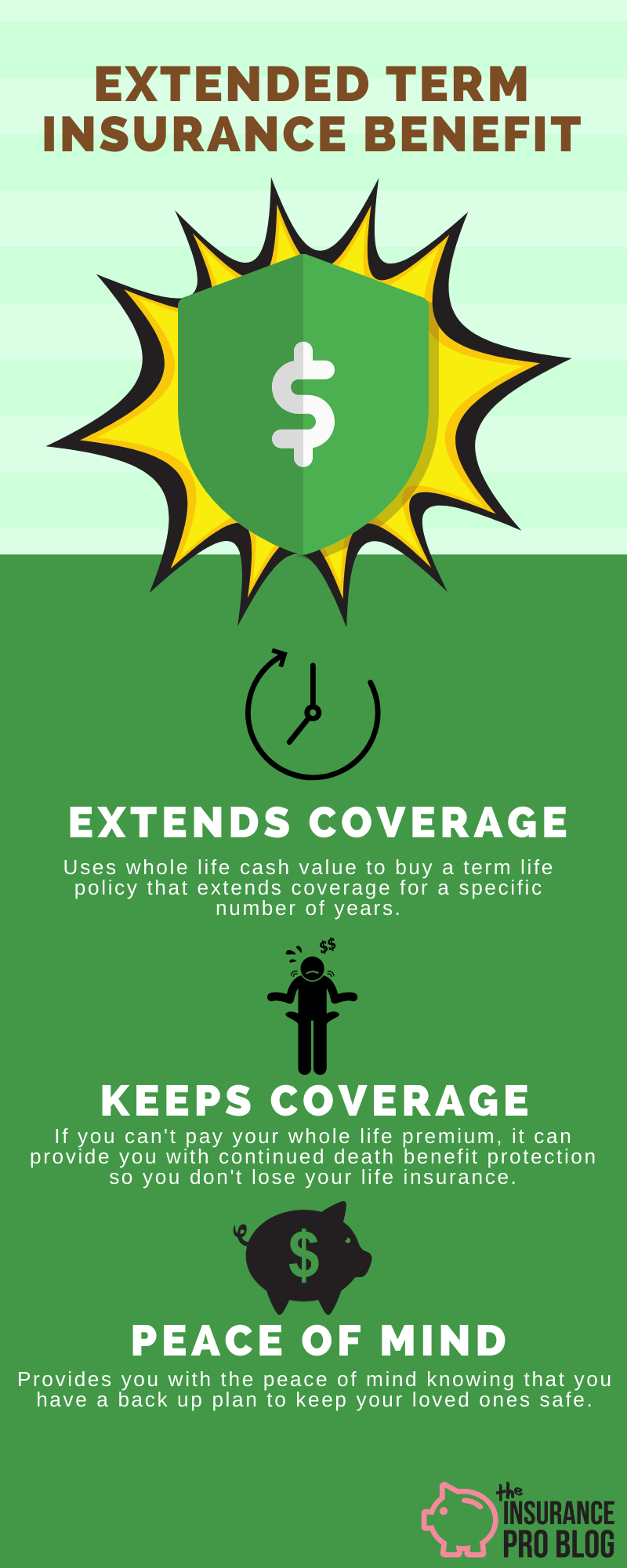Extended term insurance is a nonforfeiture option on a whole life policy that uses the policy's cash value to buy term insurance for the current whole life death benefit for a specified period of time. The feature primarily seeks to help those who find themselves in a situation where the whole life premium is no longer affordable. Instead of canceling their policy and losing their death benefit protection, the extended term insurance uses the value accumulated in the whole life policy to continue the death benefit as a term life insurance policy for a specific period of time.
Extended Term Insurance Calculation and Example
The exact calculation used by life insurers will vary from company to company, but they all will generally fall relatively close to one another. Let's assume you own a whole life policy with a $500,000 death benefit and $20,000 of cash surrender value. Due to a job loss, you no longer have the ability to pay the whole life premiums, but you still need the $500,000 death benefit provided by the policy.
In this situation, you can opt for the extended term insurance feature and keep your $500,000 death benefit for now. The insurance company will calculate how many years your $20,000 of cash value will buy you. The exact number of years is dependent on:
- The death benefit of your policy.
- Your age at the time you trigger the extended term insurance feature.
- The amount of cash value in your policy at the time you trigger the feature.
Let's assume that in this example we're using, your $20,000 will buy you 22 years of your $500,000 death benefit. This means that upon officially triggering the extended term insurance benefit, you will have a $500,000 death benefit for 22 years. You will pay no additional premiums for this $500,000 during this 22 year period.
At the end of the 22 year period, your $500,000 term life insurance policy will expire and your death benefit coverage will end.
You should know that once triggered, the extended term insurance option is generally irrevocable. In other words, you cannot undo it and return to your original whole life policy. You also cannot add money to the term life policy to keep it going longer than the original number of years.
So for example, using the figures from above, you have 22 years of $500,000 in term life death benefit. You cannot offer to pay the insurance company more money to get any extra years beyond 22.
Also, it's important to know that generally speaking the extended term insurance option is the default nonforfeiture benefit for most whole life policies. If you do not have the automatic premium loan feature selected, then the insurance company will trigger the extended term insurance feature if they do not receive your premium within the policy's grace period.
Is there Any Cash Value Accumulated After using this Option?
No, once you trigger the extended term option, all of your cash value goes towards buying the number of years you will have term life coverage. The term policy will accumulate no future cash value.
You will also no longer receive any dividends by exercising this nonforfeiture option.
You will also generally forfeit any riders attached to your whole life policy such as waiver of premium, paid-up additions, and guaranteed future purchase options.
How Does Extended Term Insurance Differ from The Reduce Paid-up Option?
Both the extended term insurance and reduce paid-up option are nonforfeiture benefits that keep death benefit protection in place. The key difference between them is that extended term insurance can keep the entire death benefit in force while sacrificing the features of a whole life policy while the reduce paid-up option will keep all whole life features intact while sacrificing some level of the death benefit.
So practically speaking, if the death benefit amount is most important, the extended term insurance option is your best bet. If the death benefit is secondary and your most important objective is the cash accumulation or tax features of whole life insurance, then the reduce paid-up option is your best bet.
Pros and Cons of the Extended Term Option
The primary benefit of the extended term insurance feature is that it keeps your death benefit protection in place at least in the short term and possibly for many years. This ensures that you have life insurance coverage if you are unable to pay your premium or if you fail to pay your premium for some reason. There is certainly some peace of mind provided by the feature knowing that your life insurance coverage will remain even if something prevents you from paying the premium.
The option, however, does shed all of the benefits of whole life insurance and generally cannot be reversed. If you plan on using your whole life policy to provide retirement income, the extended term insurance could inadvertently disrupt this plan. Additionally, the years over coverage purchased with the cash value may not be enough to provide you with adequate death benefit coverage, but if this is the case, you may not have much in the way of better options.
Ultimately, the extended term option is one of many features of whole life insurance policies. When matched to the right circumstances, it's a great worthwhile feature.

